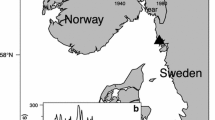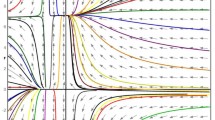Abstract
We study the viability domains of bio-economic constraints for fishing model of hermaphrodite population, displaying three stages, juvenile, female and male. The dynamic of this model is subject to two constraints: an ecological constraint ensuring the stock perennity, and an economic constraint ensuring a minimum revenue for fishermen. Using viability kernel, we find out a viability domain which simultaneously guarantees a minimum stock level and a minimum income for fleets.




Similar content being viewed by others
References
Alonzo SH, Mangel M (2004) The effects of size-selective fisheries on the stock dynamics of and sperm limitation in sex-changing fish. Fish Bull 102:1–13
Armsworth PR (2001) Effects of fishing on a protogynous hermaphrodite. Can J Fish Aquat Sci 58(11):568–578
Aubin J-P (1991) Viability theory. Birkhäuser, Boston
Aubin J-P (1997) Dynamic economic theory: a viability approach. Studies in economic theory, vol 5. Springer, Berlin, Heidelberg
Brusle J (1985) Synopsis of biological data on the groupers Epinephelus aeneus (Geoffrey Saint Hilaire, 1809) and Epinephelus guaza (Linnaeus, 1758) of the Atlantic Ocean and Mediterranean sea. FAO Fish Synop 129:1–69
Cartigny P, Gómez W, Salgado H (2008) The spatial distribution of small- and large-scale fisheries in a marine protected area. Ecol Model 212(3):513–521
Clark CW (1979) Mathematical bioeconomics: The optimal management of renewable resources. Willey Interscience Publication, Willey, New York
Doyen L, Béné C (2003) Sustainability of fisheries through marine reserves: a robust modeling analysis. J Environ Manag 69:1–13
Ferchichi A, BenMiled S, Jerry M (2012) Optimal strategy of fishing problem on hermaphrodite population. JP J Appl Math 4(1 and 2):9–25
Huntsman GR, Schaaf WE (1994) Simulation of the impact of fishing on reproduction of a protogynous grouper, the graysby. N Am J Fish Manag 14:41–52
Jerry M, Raissi N, Rapaport A (2011) A viability analysis for an explicit inshore–offshore model. J Appl Math 1(1):41–60
Jerry M, Rapaport A, Cartigny P (2010) Can protected areas potentially enlarge viability domains for harvesting management? Nonlinear Anal Real World Appl 11(2):720–734
Liu M, Sadovy Y (2004) The influence of social factors on adult sex change and juvenile sexual differentiation in a diandric, protogynous epinepheline, Cephalopholis boenak (Pisces, Serranidae). J Zool 264(3):239–248
Miled SB, Kebir A, Hbid ML (2010) Mathematical modeling describing the effect of fishing and dispersion on hermaphrodite population dynamics. Math Model Nat Phenom 5(6):159–179
Author information
Authors and Affiliations
Corresponding author
Appendices
Appendix1: Proof of Lemma (2)
Let’s consider a solution \((n_1(t), n_2(t), n_3(t))\) of (1) such that \(n_2 + n_3 \ge \alpha _1\).
In the phase plane \((n_2, n_3)\), we have above the nullcline \(\mathcal{N}_3^{min},\;\dot{n}_3\ge 0\) and below \(\bar{\mathcal{N}}_2^{min},\;\dot{n}_3\le 0\) (see Fig. 4). We shall distinguish two cases:
If \(n_2\) is decreasing, then it is necessarily above \(n'_2\) (because if the solution is in the phase plane \((n_1, n_2)\), it is to the right of \(\mathcal{L}_1\) and below \(n'_2\), then it is below \(\mathcal{N}_2^{min}\), thus, \(n_2\) is increasing).
If the solution is above \(\mathcal{N}_3^{min}\), then \(n_2\) is decreasing and \(n_3\) is increasing, the trajectory will intersect \(\mathcal{N}_3^{min}\) while checking the constraint. Subsequently, after intersection, both \(\dot{n}_2\) and \(\dot{n}_3\) are negative and thus \((n_2(t),n_3(t))\) will decrease until reaching the line \(n_2 = n'_2\). However, in parallel, in the other phase plane \((n_1, n_2)\), the solution will be below \(\mathcal{N}_2^{min}\), thus \(n_2\) becomes increasing and to the right of \(\mathcal{L}_1\). In this case, the trajectory will increase and move away from the constraint (the trajectory crosses the nullcline \(\mathcal{N}_2^{min}\) before the line \(n_2 = n'_2\)).
A same proof can be done if \(n_2\) is increasing.
Appendix 2: Proof of Lemma (3)
-
1.
If \(n''_2 > n'_2\) then \(n''_3 > n'_3\) (see Fig. 5a). Let’s consider a solution \((n_1(t), n_2(t), n_3(t))\) of (1) such that (8) and (9) are fulfilled. If \(n_2\) is increasing, then the trajectory stay viable and will move away from the two constraints since (8) and (9) are always verified. If \(n_2\) is decreasing then after a certain time, the trajectory will cross the nullcline \(\mathcal{N}_3^{min}\). Accordingly, we have both \(n_2\) and \(n_3\) are decreasing. In parallel, in the other phase plane \((n_1, n_2)\), the trajectory will intersect \(\mathcal{N}_2^{min}\) before reaching \(n''_2\). Thus \(n_2\) becomes increasing, the trajectory will go away from the constraints and it will be viable.
-
2.
If \(n''_2 < n'_2\) then the viability domain which satisfies (8) and (9) is the domain \(\mathcal{V}_1 \cap \mathcal{D}_2\). Same proof as the first case (see Fig. 5b).
Appendix 3: Proof of Theorem (2)
-
1.
If \(n''_2 > n'_2\) and \(n'''_3 > n''_3\) ie \(n'''_2 > n''_2\), then \(\mathcal {V} = \mathcal{V}_3 \cap \mathcal{D}_2\).
Let’s consider a solution \((n_1(t), n_2(t), n_3(t))\) of (1) such that (8)–(10) are verified. If it is above \(\mathcal{N}_3^{min}\), then \(n_3\) is increasing. In the two cases (\(n_2\) is increasing or decreasing), the trajectory is viable and moves away from all constraints (see Fig. 6a).
If the solution is below \(\mathcal{N}_3^{min}\), then \(n_3\) is decreasing: consequently, if \(n_2\) is increasing and located above \(\mathcal{L}_3\), The trajectory will go away from all constraints. If \(n_2\) is decreasing, then in the phase plane \((n_1, n_2)\), the trajectory will intersect \(\mathcal{N}_2^{min}\) before reaching the line \(n_2 = n'''_2\). Below \(\mathcal{N}_2^{min}\), \(n_2\) becomes increasing and the trajectory will increase and moves away from all constraints.
-
2.
If \(n''_2 > n'_2\) and \(n'''_3 < n''_3\) ie \(n'''_2 < n''_2\), then \(\mathcal {V} = \mathcal{V}_2 \cap \mathcal{D}_3\). Same proof as the previous case (we replace \(n''_2\) by \(n'''_2\)). Figure 7a explains the situation.
-
3.
If \(n''_2 < n'_2\) and \(n'''_3 > n''_3\) and \(n'''_3 < n'_3\), then \(\mathcal {V} = \mathcal{V}_1 \cap \mathcal{D}_2 \cap \mathcal{D}_3.\) Analogous proof as the first case. Figure (7b explains the situation.
-
4.
If \(n''_2 < n'_2\) and \(n'''_3 > n''_3\) and \(n'''_3 > n'_3\), then \(\mathcal {V} = \mathcal{V}_3 \cap \mathcal{D}_2\). Analogous proof as the first case.
Rights and permissions
About this article
Cite this article
Ferchichi, A., Jerry, M. & Miled, S.B. Viability Analysis of Fisheries Management on Hermaphrodite Population. Acta Biotheor 62, 355–369 (2014). https://doi.org/10.1007/s10441-014-9228-6
Received:
Accepted:
Published:
Issue Date:
DOI: https://doi.org/10.1007/s10441-014-9228-6







